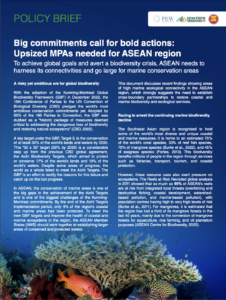Background
The ASEAN region is rich in biological diversity. The region occupies only three per cent of the world’s surface, yet it is home to approximately 19 per cent of all known species. Indonesia shows the highest biodiversity worldwide, while Myanmar ranks second within the ASEAN region.
Nevertheless, biodiversity is endangered due to rapid population expansion, persistent poverty, fast economic growth, as well as human intervention. Humans convert natural resources into resources that will satisfy their needs for survival, such as forests converted into grazing land to raise animals for profit. Humans are important considerations in conserving biodiversity; thus, to keep them from relying solely on natural resources, humans need to have alternative sources of income. Within these contexts, the Federal Government of Germany through the KfW Development Bank, has provided financial support to the Small Grants Programme (SGP) of the ASEAN Centre for Biodiversity (ACB).
The SGP is implemented in the ASEAN Heritage Parks (AHPs) of Indonesia and Myanmar, while the SGP II is implemented in the AHPs of Viet Nam.
Implementing Partners



What's New
News and Updates
Publications and Resources
Impact Stories
Objectives
Biodiversity conservation and management of natural resources in line with the basic needs of the people of ASEAN by strengthening the ASEAN Centre for Biodiversity
Improve biodiversity protection in line with the
interests of the local population directly
dependent on selected AHPs and adjacent areas
Strengthen the role of ACB in promoting
biodiversity protection among the ASEAN
Member States
COMPONENTS
Small Grants Programming

Regional Coordination and Management

Consultant

SGP Indonesia:
Where biodiversity meets sustainable livelihood
Other Videos
Indonesia

Implementation Sites:
- Gunung Leuser National Park
Way Kambas National Park

Way Kambas National Park (WKNP)
WKNP is the oldest reserve in Indonesia and is home to the Sumatran Elephant. The park management faces several challenges...
Gunung Leuser National Park (GLNP)
GLNP is a national park in Indonesia that covers almost inaccessible mountains. The Alas River runs through the park, which...
27,164.15 hectares
protected and monitored
270,100 hectares
rehabilitated
3,538 beneficiaries
trained with various capacity development activities
(1,653 GLNP and 1,875 WKNP)
27 new products
developed under the livelihood model

12 locations
facilitated for ecotourism development

1,515.50 hectares
area of managed conservation partnerships
contributed to conservation of key species:
Orangutan, Tigers, Rhinoceros, and Elephants
75 total grantees
in SGP Indonesia

Myanmar
Implementation Sites:
- Alaungdaw Kathapa National Park
- Indawgyi Lake Wildlife Sanctuary
- Meinmahla Kyun Wildlife Sanctuary
- Nat Ma Taung National Park

133,780 seedlings
produced

12 village waste
managed
30 handy pods
installed
27 participants
trained on Protected Area Management Planning

8 trainings
conducted at national level as of June 2023
160 acres community forestry
established

Viet Nam
Implementation Sites:
- Ba Be National Park
- Chu Mom Ray National Park
- Hoang Lien National Park
- Kon Ka Kinh National Park

12 village waste
managed
30 handy pods
installed

133,780 seedlings
produced
4 Heritage Parks
restored

130,000 hectares
rehabilitated
10 per cent
mammal species in world
4 per cent
of its flora are endemic
Related Pages

Field Guide to the Plants of the Deer Cave Trail
Located 100 km east of Miri, Gunung Mulu National Park is the largest national park

ACBeats-2017-Q4
Warmly welcomed by children clad in ASEAN costumes, Dr. Cristiana Paşca Palmer, the newly appointed

Tarutao National Park
In the dialect of Southern Thailand, Tarutao means “old, mysterious and primitive”, which describes this




























